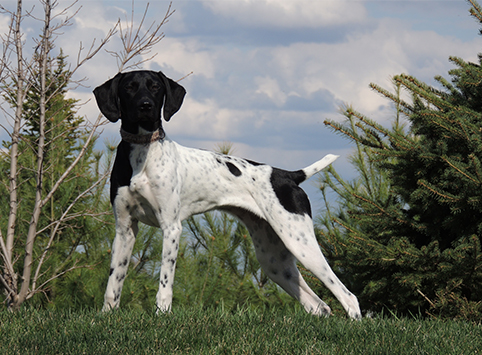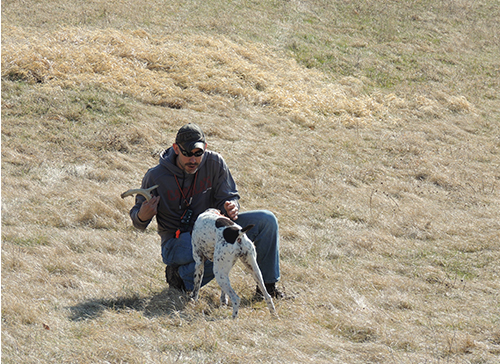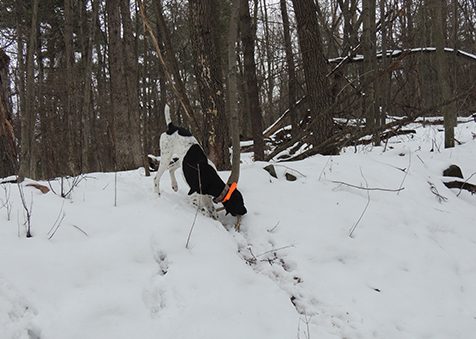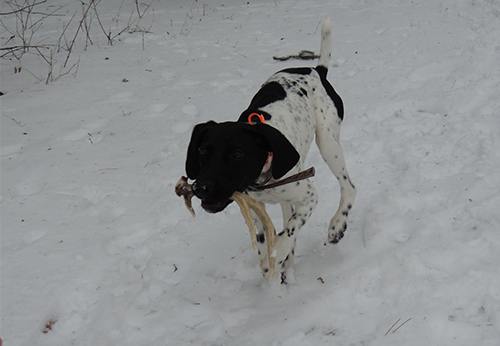Bird Dog to Shed Dog - Pointless or Possible?
How to get started training a dual-purpose dog.
April 17, 2017
Source: John Beyer, Jr.
To have a pointing dog that is versed in both hunting upland game, holding point and retrieving is something that is very rewarding. Many think that if a pointing dog is used for shed hunting it will point the sheds instead of retrieve them. Can a pointing dog be used to retrieve shed antlers and still point birds? The short answer is yes, but like anything in the dog world it takes time, hard work and patience.

German Shorthaired Pointer owned by author John Beyer.
With the proper training and having a dog capable of scent recognition, your pointing dog can point birds as well as retrieve sheds. If you have a pointing dog breed, I will assume you love bird hunting as a primary sport with your dog. To see a dog lock on point, not a muscle moving, just the dog’s nostrils soaking in scent, gets my adrenaline pumping. But, when that dog that was locked on point is running through the woods, turns on a dime at the scent of a shed and then comes running back head held high with that shed, you know you hit the jackpot. So, how do you get started on training a dual purpose dog?
The first key to dual training a pointing dog is starting scent introduction early with your pup. From my personal experiences with my own bird dogs, it is a lot easier to start with a young pup, but it is possible to teach an already fully-trained pointing dog to be a shed finding machine. This article focuses on pup training, but many of the techniques can be applied to adult dogs as well. Additionally, if you are truly training for dual purpose pointing and sheds, it’s important to realize that to your dog hunting a warm, living bird is top-notch excitement, but searching for a cold, hard deer shed while fun, is not the same level of elation at first. Fun, consistent training is important.

Author John Bayer training one of his Shorthairs.
Ideally, pups are introduced to a wing on a string at 6 to 10 weeks old to get introduced to the concept of standing still and pointing when they smell and perceive a bird. For shed scent introduction, I have found throwing a balled-up sock with shed scent on it works great to introduce not only the smell of deer antler scent, but also the idea that this smell means fun. Young pups are full of playful energy and are mentally developing every day. When I throw the scent sock ball for the first few times, the commands I introduce are light and easy; this allows the pup to feel free to break and chase the sock. After a few short sessions of this, I like to hang onto my pup and release her for the retrieve with a command. This activity will aid in future steadiness training down the road. As a dual-purpose trainer, you need to remember to keep in mind what your overall goal of training is and how training activities may be able to be utilized with minor tweaking resulting in activities that can cross-transfer between bird work and shed work.
Now you have a pup that will point a wing on a string and retrieve a sock with shed scent on it. You are ready for the next step, a ball with shed scent on it. While there does not seem to be much difference between the sock and ball, for your dog there is a huge difference in texture. Sheds are hard, cold bone and it is very important to take little steps to develop your pup’s confidence at this point. I like to utilize tennis balls for this step, because they will easily absorb and hold scent. Simultaneously, I will start to introduce a small bumper or ball with bird scent on it as well. I use one command to retrieve, but two separate commands for what my dog is retrieving, "shed" - "bird." For example, I will throw the ball with bird scent and the command will be “fetch (or find) the bird,†whereas a ball with shed scent and it will be “fetch (or find) the shed.†It is very crucial to remember at this point to NOT throw both scents during one session; separate your training time into short periods, each dedicated to a specific idea, sheds or birds. For example, one training session for 10 minutes with sheds in the morning and one 10-minute evening training session with birds, but never together yet. Remember, little steps!
Once your pup is retrieving a ball with scent on it confidentially and hopefully with a lot of enthusiasm, it is time to move on and find yourself a spike antler or even a tine. Be sure to sand all sharp edges off the antler to ensure safety for your pup. Next, cut two small holes in the tennis ball you had previously been using with the shed scent and put the shed through the tennis ball. You have just created a “shed ball.†Start throwing the shed ball for your pup. At this point you are introducing the actual shed. Once your dog is smoothly retrieving the shed ball, you can take the shed out of the tennis ball and start throwing the small antler by itself. It is important to remember to not rush this process. Building your pup’s confidence is huge at this point. Be sure to keep your training sessions upbeat and enjoyable for both yourself and your pup.
Once your pup is confident with retrieving a real shed, start making things a little harder by throwing the shed in some light cover. At this point, your dog can no longer simply rely on its eyes to find the shed and needs to start really putting its nose to work hunting for the antler. This goes hand-in-hand with bird work; your dog needs to find the object it is hunting for, whether antler or live bird. At this point in training I release my dog to the command to hunt/search for the shed. By the time your dog reaches this point of shed training, ideally your dog should be well into bird work, able to hunt and point birds.

Be sure to keep your training sessions upbeat and enjoyable for both yourself and your pup.
Once your dog is retrieving sheds out of cover, it’s time to step up the game. Now, while your dog is out of eyeshot, strategically place a shed so it would represent an actual shed hunting scenario. This time when you release your dog give it a command to hunt for the shed (“find the shed,†“find the bone,†“fetch the boneâ€). The key to remember is consistency. For birds you could use commands like “hunt’em up,†just never use the word find “fetch.†By now your dog should have instilled in its mind that the words “fetch†or “find†mean to search and pick up something (retrieve).
During the stage of introducing your pup to the shed ball, you can also use the DogBone rubber shed. It is another tool in the toolbox. As Jeremy Moore said, “You do not want to make your dog shed shy.†If a dog or pup gets poked with a tine and gets hurt, the game is over and you no longer will have a shed dog. Think of it in terms of introducing gunfire or birds to a pup. The first experience should never be a bad one; it should be fun and exciting for your pup.
Through my experience, I have found that when you are dual training for birds and sheds it is very important to train both concepts simultaneously, but not during the same exact training sessions. Look ahead in your week and plan what you are going to train when. For example, Monday plan to train sheds and Tuesday focus on birds. Short, focused training sessions will result in greater benefits. Your pup will not forget what you have engrained in its development.
The fun really starts once your dog has a full season under its belt of both shed work and bird work. At this point, it’s safe to challenge yourself and your dog and hide a bird and a shed in the same vicinity. Release your dog and watch the magic. If the proper introduction was done, and the training sessions were kept separate and clear while the dog was learning, you will be amazed when your dog points the bird and then finds and retrieves the shed or vice versa. With the proper training, your dog will easily differentiate between jobs.

With the proper training, your dog will easily differentiate between jobs.
Somewhere along the line your dog may point a shed instead of retrieve it. If that is what you want, encourage it. If your end goal is for your dog to point birds and sheds, you must restructure this training schedule from the start and instill in your pup or dog to point shed scent too. If you have an older dog and start shed training later in life, your dog will most likely point a shed with ease once introduced. On the other hand, you may need to just refresh the pointing of birds and work the sheds in every now and then. I personally took my two pointing dogs and started shed work when they were 7 years old. It was an easy transition for them, but I did lose some steadiness on point with them and had to revisit bird work to get them back to steady to wing.
In conclusion, your pointing dog, no matter how old it is, can be a shed finding machine. Your training method will determine whether the dog points a shed like a bird or delivers to hand. It just takes hard work and time! Keep the work short and enjoyable for all involved, and you’ll have a successful shed dog in no time!
About the author: John Beyer is an avid bird hunter, shed dog enthusiast, and outdoorsman. He lives in Bloomer, Wisconsin with his wife, Brittany; daughter, Laikyn; and son, Jack. The Beyer family has three German Shorthaired Pointers with whom they enjoy bird and shed hunting alike. John and wife Brittany started shed hunting in 2014 by training their two 7-year-old GSP's for shed hunting as a fun family activity in the off season from bird hunting.
